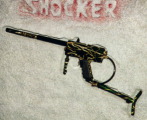
This FAQ is designed to provide information reguarding Smart Parts Paint
Marker, "The Shocker". It is my hope that this FAQ will help
provide useful factual information about this marker. I have made every
effort to be as accurate and helpful as possible.
The Shocker is divided into two major assemblies: the body assembly, and the grip assembly.
The grip assembly houses the actual electronics inside the gun. The solenoid valves, arm/disarm switches, trigger and remote trigger assemblies.
a. The lower left side of the body houses 4 'AA' batteries. Smart Parts claims the batteries have an expected life of 75,000 to 100,000 shots. But also recommends changing them on a monthly basis. I investigated the possibility of using rechargable batteries, but found that most rechargable batteries have a functional voltage of 1.2VDC, while alkaline batteries are rated at 1.5VDC. So I decided to stay with the alkaline batteries.
b. In the lower right side of the gun is a chamber that houses a mechanism that controls the firing of the gun. When pressure is first applied to the gun, a piston is driven into an air chamber, this piston then opens a poppet that allows inlet gas to charge the air chamber. During the firing sequence, the firing selonoid alternately pressurizes the firing piston. When the piston is extended, the fill poppet opens, and when the piston is retracted, the fill poppet closes. This alternating motion constitutes one full firing cycle.
c. Just between these two areas is a gas manifold chamber which serves as a distribution area for various gas requirements of the marker.
d. The upper,center chamber houses the bolt assembly. When pressure is initially applied to the gun, the bolt is driven to its closed position. With the first trigger pull, the bolt opens, a paintball drops in, and the bolt closes. The gun is then ready to fire. Going from its closed to open and back to closed posistion, comprises one firing sequence.
e. Also attached to the bottom of the body assembly are two solenoid valves. A solenoid valve is simply a valve that opens and closes and controls the flow of air, liquid, or whatever is being controlled. The solenoid valves in the Shocker serve as the interface between the electronics and the gas distribution manifold.
f. A sight rail has been thoughtfully machined into the top of the gun.
| Copyright © 1992-2019
Corinthian Media Services. WARPIG's webmasters can be reached through our feedback form. All articles and images are copyrighted and may not be redistributed without the written permission of their original creators and Corinthian Media Services. The WARPIG paintball page is a collection of information and pointers to sources from around the internet and other locations. As such, Corinthian Media Services makes no claims to the trustworthiness or reliability of said information. The information contained in, and referenced by WARPIG, should not be used as a substitute for safety information from trained professionals in the paintball industry. |